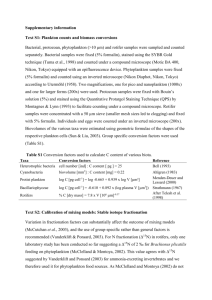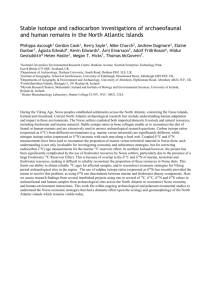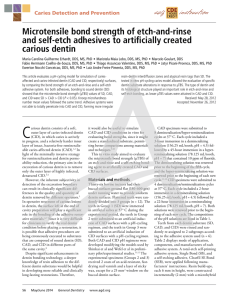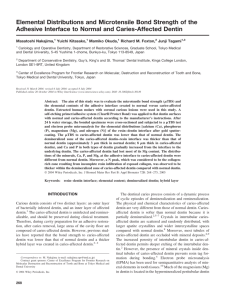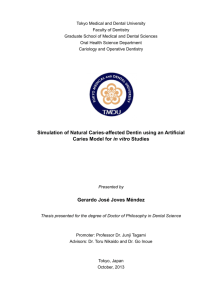rcm7073-sup-0001-SI
advertisement
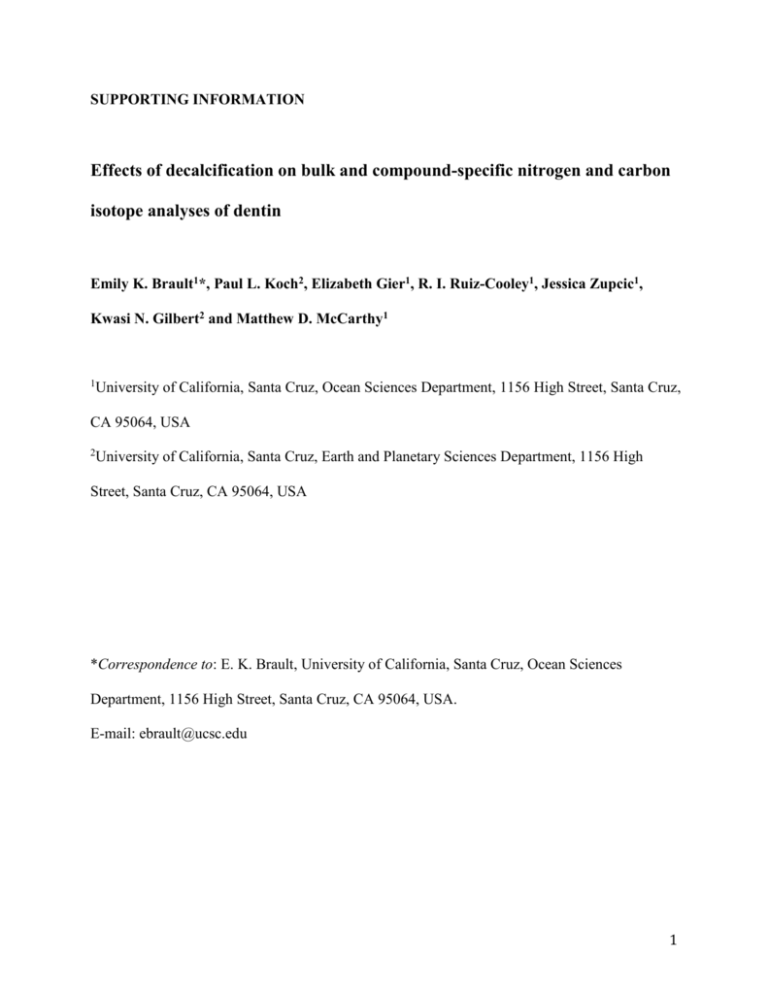
SUPPORTING INFORMATION Effects of decalcification on bulk and compound-specific nitrogen and carbon isotope analyses of dentin Emily K. Brault1*, Paul L. Koch2, Elizabeth Gier1, R. I. Ruiz-Cooley1, Jessica Zupcic1, Kwasi N. Gilbert2 and Matthew D. McCarthy1 1 University of California, Santa Cruz, Ocean Sciences Department, 1156 High Street, Santa Cruz, CA 95064, USA 2 University of California, Santa Cruz, Earth and Planetary Sciences Department, 1156 High Street, Santa Cruz, CA 95064, USA *Correspondence to: E. K. Brault, University of California, Santa Cruz, Ocean Sciences Department, 1156 High Street, Santa Cruz, CA 95064, USA. E-mail: ebrault@ucsc.edu 1 Table S1. Mass balance calculation for determining the effect of carbonate on raw dentin δ13C values. The table outlines a calculation to estimate potential effect of apatite on raw dentin δ13C values. Values on the right above the line are the measured fractional concentrations of carbonate and collagen carbon in raw whale dentin, as well as the measured δ13C values for purified apatite or collagen. The calculation estimates that raw samples should be only ~0.1‰ 13C-enriched relative to the collagen produced by conventional decalcification Component in Mass Balance Calculation Value Bulk fraction mineral Bulk fraction protein 0.76 0.24 Fraction carbonate in bioapatite (measured) Fraction carbon in carbonate (assumed) Fraction carbon in bioapatite Fraction carbon in collagen (measured) Fraction nitrogen in collagen (measured) 0.04 0.2 0.01 0.43 0.16 Fraction carbonate carbon in raw dentin (Xcb)* Fraction collagen carbon in raw dentin (Xcl)* 0.06 0.94 Fraction carbon in bulk Expected fraction carbon in bulk Fraction nitrogen in bulk Expected fraction nitrogen in bulk 0.11 0.13 0.037 0.045 13C carbonate (13Ccb) 13C collagen (13Ccl) 13Ccb - 13Ccl -10.9‰ -12.9‰ 2.0‰ C/N of collagen Expected C/N of collagen C/N of bulk Expected C/N of bulk 2.76 2.76 2.92 2.95 13Cbulk = Xcb*13Ccb + Xcl*13Ccl 13Cbulk - 13Ccl -12.8‰ 0.1‰ 2 * 3 Figure S1. Average isotope values for conventionally decalcified and raw dentin for threonine (Thr). The average δ15N values of conventional samples (n = 3) are indicated with white squares and the average δ15N values of raw samples (n = 3) are indicated with grey circles. As noted in the text, Thr values are typically extremely 15N-depleted relative to other amino acids, and Thr falls into neither the “source” nor the “trophic” AA groups. Thr is sometimes classified as a “metabolic” amino acid, but its systematics is not well understood. The large analytical error bars result from more difficult chromatographic separation, coupled with increased tailing for the Thr peaks. For both these reasons, Thr values are not considered in the isotopic comparisons in the main text. 4 40 * 30 * * 20 * 10 * Ly s lu * G Ile Pr o+ A sp Va l Le u Th r Se r ly G 0 A la * * Ph e Mole Percent (%) Raw Conventional Amino Acid Figure S2. Alternative amino acid molar percentage calculation for decalcified and raw samples. An alternative Mol% calculation based on CO2 peak sizes from the δ13C-CSIA analysis runs was also performed. Relative amino acid abundance was calculated as described in the text, based on injections of the same TFA derivatives, but with the GC/C-IRMS instrument configured for δ13C analysis. Overall, the results are very similar to those derived from δ15N runs, including the magnitude and direction of the main offsets in Ala, Gly, and Pro+. In theory, a difference between these two approaches in quantification should only result from relative error in quantification and chromatography, or possible changes in oxidation / reduction. Because the δ15N runs were cleaner and more reproducible, we chose those as our primary data (Fig. 4). Significant differences are indicated with asterisks and bold font (p = 0.02, 0.002, 0.006, <0.001, 0.002, 0.03, 0.04, 0.0002 for Ala, Gly, Thr, Ser, Pro+ (Pro + Hpro), Asp, Glu, and Phe, correspondingly; Student’s t-tests). 5 Testing an Alternative Decalcification Approach One alternative decalcification approach is to treat a sample with HCl to remove carbonate, but then dry and analyze it without discarding the supernatant (or rinsing). This procedure is not commonly applied in tooth or bone studies (because the inorganic matrix remains), so it did not constitute our main comparison. However, a similar approach has been used, for example, in the analysis of carbonate-rich sedimentary organics. In such a procedure, none of the decalcification solution (or the hydrolysis solution for CSIA) is ever discarded. Therefore, this approach should in theory have the advantage of removing carbonate, yet retaining all non-volatile organics (including all amino acids). However, like the analysis of raw bone or dentin, the presence of inorganic components, as well as new inorganic chlorine compounds formed during acidification, could still have a major impact on the chromatography and the CSIA. We conducted some preliminary experiments to evaluate if this approach had enough promise to merit further testing. Subsamples of the same tooth dentin used for our primary comparison were acidified as with the conventional decalcification protocol described in the main text, but the samples were then left in a 4C refrigerator for ~ 22 hours. We then attempted to remove HCl by heating samples to 65C under a stream of nitrogen gas, but presumably due to the extremely hygroscopic nature of the compounds (in particular new Cl-containing compounds) these samples would not dry completely under heat and N2 gas. We ultimately removed all acid with sequential rinses/evaporation with Milli-Q water (to neutral pH), and the samples were then frozen (-20C) and lyophilized. After freeze-drying, the samples were stored in a vacuum desiccator until either EA or CSIA analysis. Ultimately, the large amounts of calcium, phosphate, and added Cl remaining in the residue led to multiple difficulties for both bulk and compound-specific isotope analysis. For 6 example, after dry down for bulk isotope analysis, the sample weights were highly variable and sometimes greater than the initial weight of the dry sample powder. The samples often rapidly gained mass as we attempted to weigh them, as expected if extremely hygroscopic CaCl2 was present. The bulk isotope results for these samples were not only highly variable compared with either conventionally decalcified or raw samples (Fig. S3), but also had strongly offset (and so presumably inaccurate) bulk 13C and 15N values. This suggests that the major issues were related to newly formed Cl-containing compounds, as opposed to native inorganics in the tooth matrix. For CSIA, the samples exhibited similar difficult behavior (“gel” formation of solutions) from that described in the main text for raw samples. Furthermore, the chromatographic values were even more variable (data not shown). Overall, based on this raft of issues with our initial tests, we concluded that this approach did not merit further detailed investigation. 7 -12.0 Mean = -12.9±0.2 -12.5 Mean = -12.9±0.1 Mean = -13.7±0.6 Bulk ! 13C -13.0 -13.5 -14.0 -14.5 -15.0 Conventional Raw Alternative 17.5 17.0 Mean = 16.6±0.1 Bulk ! 15N Mean = 16.6±0.1 16.5 Mean = 16.1±0.3 16.0 15.5 Conventional Raw Alternative Figure S3. Comparison of bulk δ13C and δ15N values for raw dentin and two different approaches to decalcification. Data are for conventionally decalcified dentin (white), raw dentin (dark grey), and alternatively-decalcified dentin (light grey). Isotope values are much more variable for alternatively-decalcified dentin than for raw or conventionally decalcified dentin. 8 Chromatographic Precision for Raw and Conventionally Decalcified Samples We evaluated the analytical precision for replicate injections of conventionally decalcified (n=3) and raw dentin samples (n=3) to test if the different matrix in the two sample-solution types affected the precision. For all the amino acids, the mean δ15N standard deviation for each of the three decalcified samples was not significantly different from the corresponding mean of the δ15N standard deviations for raw samples (Fig. S4, top panel). Likewise, for all 13 amino acids, the mean of the δ13C standard deviations for each decalcified sample was also similar to that of the raw samples (Fig. S4, bottom panel). The similarity in the analytical precisions for conventionally decalcified and raw dentin samples suggests that the presence of the inorganic matrix in the raw sample derivative solutions (before gel formation began, as described in text) does not increase variability in the GC/IRMS measurement of amino acid δ13C and δ15N values. For the δ13C and δ15N values, the averages of the standard deviation means across all amino acids for conventional and raw samples are not significantly different. Variability around this mean was greater for the δ15N values than for the δ13C values for conventional and raw samples only due to the high standard deviations of the δ15N Thr measurements. 9 2.0 1.5 1.0 0.0 Ile Pr o H pr o As p G lu Ph e Av Lys er ag e 0.5 Al a G ly Th r Se r Va l Le u ! 13C Standard Deviations Conventional Raw Amino Acid 3.0 Conventional Raw ! 15N Standard Deviations 2.5 2.0 1.5 1.0 As p G lu Ph e Av Lys er ag e Pr o+ Ile 0.0 Al a G ly Th r Se r Va l Le u 0.5 Amino Acid Figure S4. Analytical variation (standard deviation) for replicate injections of conventional-decalcified and raw dentin samples for δ15N (top panel ) and δ13C analysis (bottom panel). The mean of the standard deviations across all amino acid is also shown (“Avg”). No statistically significant differences were found between raw (dark grey) and conventional (light grey) standard deviations for any amino acids or for the mean of standard deviation means for all amino acid (Student’s t-test). 10
